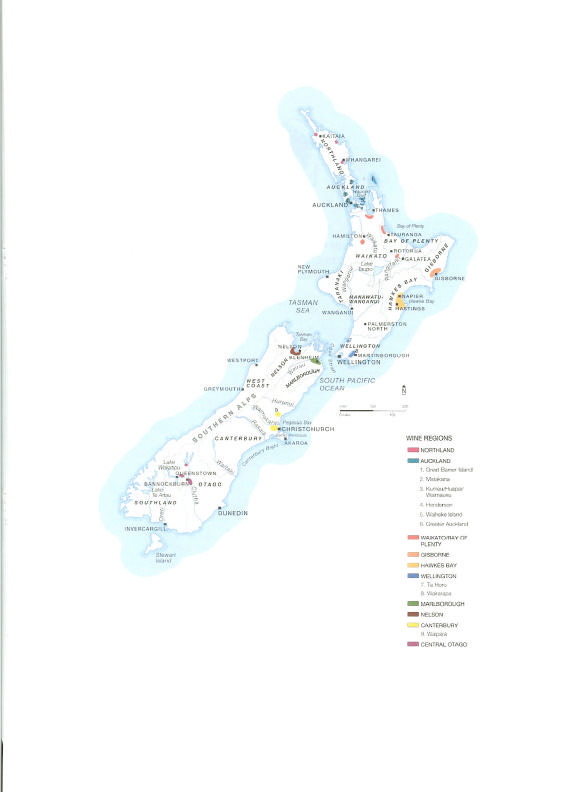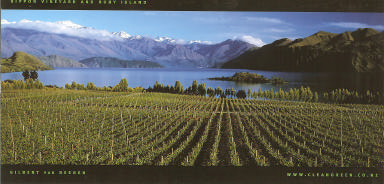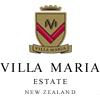Newer New Zealand Arrivals
Periodically I like to sample some of the New Zealand Pinot Noirs that reach the western shores here in
the United States, Although 55% of New Zealand’s wine production is exported and Pinot Noir exports
are growing at a 56% clip, only a smattering appear in fine wine retail stores here.
Geographically, New Zealand has both a North Island and South Island. In all, there are ten major
wine regions. On the North Island are Northland, Auckland/Waiheke Island, Waikalo/Bay of Plenty,
Gisborne, Hawkes Bay and Martinborough. Only Martinborough at the southern tip of the South Island
is suitably cool for Pinot Noir. On the South Island are Marlborough, Nelson, Waipara/Canterbury and
Central Otago, all of which have climates ideal for Pinot Noir. A map of New Zealand is on page 11.
Some of New Zealand’s oldest plantings are in Martinborough. Most of the wineries are boutiquescale
growers. The Pinot Noirs often show a more Côte de Nuits character with notable earthiness,
firm structure, and dark cherry flavors.
Marlborough is the largest winegrowing region in New Zealand. It is known for the Sauvignon Blanc
that thrives in the sunny climate here, but half of the Pinot Noir in New Zealand is grown in Marlborough.
The original vineyards here were clustered in the Wairau Valley, but new growth is expanding
into the hillsides of many neighboring valleys like Waihopai, Omaka, Brancott and Awatere.
Nelson is a province and town of the same name, located at the northern tip of the South Island two
hours from Marlborough. Most of the wineries here are family owned.
Waipara is the one area in New Zealand that has chalky loam soil with limestone. Sheltered from the
sea by low lying hills, the combination of soils and microclimate have created a region of great promise
for Pinot Noir.
Central Otago is the planet's most southerly wine region. It is the fastest growing wine region in New
Zealand. In 1995, there were 114 acres of vines here, and by 2006, 2,845 acres were planted, 70% to
Pinot Noir. The climate in Central Otago is more continental than any other wine growing region in
New Zealand for it is distanced from the ocean. Mountains are a prominent feature with snow in the
winter, but plenty of sun in the summer and autumn. The growing season is not long, but the absence
of a wet maritime influence allows tannins to ripen and acidity is retained without sugars becoming
excessive. About half of the Pinot Noir here is made by the wineries or made by co-ops, the other half
is put into Central Otago blends. Rolfe and Lois Mills of Rippon Vineyard by Lake Wanaka in Central
Otago were the first to plant experimental vitis vinifera in New Zealand in the 1970s. In 1982, after
years of research, they planted the Rippon vineyard , Central Otago’s first commercial block of vines.
Later, in 1991, Felton Road became the first major vineyard and winery in Central Otago. Today there
are a long list of Pinot Noir producers scattered over five sub regions of Central Otago (Gibbston,
Cromwell, Bannockburn, Wanaka and Alexandra). Many critics feel Central Otago is the chosen spot
for New Zealand Pinot Noir.
The style of New Zealand Pinot Noir is still evolving as it is relatively young wine industry. A whole
range of wines are produced, from elegant, feminine and classic Pinot Noirs, to more earthy, mineraldriven
styles, to heavily-oaked, fruit bombs. Recurring criticism has been that the wines are overextracted,
unbalanced and lack complexity. Sommelier Rene Chazottes notes, “The Pinot Noirs
possess plenty of fruit but not sheer power. They are layered and sinewy and are fruit-driven with a
strong acid backbone.” Henry Hariyono writes, “The style of Pinot Noir made in Central Otago is much in demand among younger wine drinkers in the United States today. With their rich, dark fruit
aromas and flavors, intriguing floral and mineral nuances and ripe, harmonious acidity - not to mention
their often considerable heft (typically 14% alcohol) - they pose a threat to the more established Pinots
of Martinborough, which while often more complex, earthy and Burgundian, can come off as drier and
leaner in comparison with the fruit bombs of Central Otago.”

New Zealand vineyards have long been farmed with organic and sustainable methods. The viticulture
scheme has always encouraged non-irrigation of vineyards and avoidance of insecticides. The New
Zealanders have pioneered the use of screwcaps for their wines and most wineries now use screwcaps
exclusively.
The most recent vintage, 2006, was of high quality. Overall grape tonnage was up 11% due to an 18%
increase in producing vineyard area since 2004. The Pinot Noir harvest was increased by 50% compared
to 2005. There was good warm summer and autumn weather. 2005 was a more difficult vintage
with cool weather during flowering limiting yields and autumn frosts. 2007 produced a record harvest
up 11% over 2006 sparked by excellent late summer and autumn weather.
Unfortunately, many of the best New Zealand Pinot Noirs cannot be found in America. Many of the
small, special boutique wineries sell their entire production in New Zealand or in countries where
demand is established. For smaller wineries, it is difficult to organize distribution in enough areas
here in the States to justify the expenses of export. Prices for New Zealand Pinot Noir are comparable
to their counterparts in California and Oregon. In general, Central Otago Pinot Noir demands the
highest prices.
Martinborough
2005 Ata Rangi Martinborough Pinot Noir
13.5% alc., $37, screw cap. Imported by Epic Wines,
Aptos, CA.
·
Darkly colored with pleasing cherry, spearmint and herbal aromas. Bitter woody, vegetal
and medicinal flavors mar the enjoyment. Disappointing for the money. Website: www.atarangi.co.nz.
Marlborough
2005 Villa Maria Estate Reserve Marlborough Pinot Noir
13.5% alc., $36, screw cap.
Imported by Vineyard Brands Inc., Birmingham, AL. This wine is a blend of
the best clones from several vineyards in the Marlborough region. It is aged 9
months in 40% new French oak.
·
Richest, darkest fruit of all the wines sampled. Deep
and bright black cherry perfume that is quite appealing. A riper style packed with
sappy plum and blackberry fruits and a charred oak overlie that enhances the generous
flavors. Tannins are like felt and the whole package is nicely balanced.
2005 Vidal Wines Estate Marlborough Pinot Noir
14% alc., $17, screw cap. Imported by New Zealand
Pure, Issaquah, WA. Founded in 1905, Vidal is one of Hawkes Bay’s oldest boutique wineries.
Grapes are sourced from the Awatere and Wairau river valleys.
·
Simple black cherry and subtle spice
aromas and flavors with barely detectable tannins. Straightforward with commendable balance. Well
worth the asking price. Website:www.vidal.co.nz.
Central Otago
2005 Amisfield Central Otago Pinot Noir
13.9% alc., $36, screwcap. Imported by Pasternak Wine
Imports, Harrison, NY.
·
Cherry driven nose and tastes with a deft touch of oak. The attractive aromatics
trump the simple fruit flavors. Website: www.amisfield.co.nz
2006 Felton Road Central Otago Pinot Noir
14.5% alc., $38, screw cap.
Imported by Wilson Daniels, St. Helena, CA.. Sourced from the Bannockburn
Vineyard.
·
A complex nose with heady crushed cherry, plum, pepper and hay. A
little heat peaks out but is not intrusive. Red and blue fruit flavors lead to a tangy
citrus and cherry ending. The most striking feature of this wine is the powerful and
persistent finish.
2006 Kirkland Signature (Costco) Central Otago Pinot Noir
13.5% alc., $18, screwcap. Produced
by Wild South Vineyards, Marlborough and imported by Petco Inc., Lake Charles, Louisiana.
·
Strawberry
and cherry aromatic and flavor profile with hints of oak and herbs. Alcohol peaks out from start to
finish. Just ok.
2004 Rippon Central Otago Pinot Noir
13% alc., $36. Imported by Station
Imports, Colorado Springs, CO. Nicholas Mills, son of founder Rolfe and Lois
Mills, is now the winemaker here and several other family members run this
winery. Nicholas spent four years living in France studying viticulture and winemaking
in Burgundy and Alsace. He worked for and was mentored by Alain et
Sophie Meunier from Domaine Jean-Jacques Confuron, Nicolas Potel of Maison
Nicolas Potel, Pascal Marchand of Domaine Vougeraie de Beauclair, and Aubert
de Villaine of Domaine de la Romanee-Conti. Upon returning to the family vineyard in 2002, Nicholas
instituted biodynamic farming with no herbicides. The vineyard, along the shores of Lake Wanaka
and probably the most photographed in the world, is non-irrigated and virtually all on it’s own roots.
·
Light in color. Sensual perfume of cherry, toast and spice. Sappy red fruits kissed by cinnamon spice,
velvety tannins and a clean finish with admirable length. Elegance personified. A complete wine. The
website is www.rippon.co.nz.

2006 Valli Bannockburn Vineyard Central Otago Pinot Noir
13% alc., $40, screw cap. Imported by
RO Imports LLC, Napa, CA. Giueseppe Valli emigrated from an Italian winemaking background to
New Zealand in the 1870s. Five generations later, great-grandsons Grant Taylor and Tim Valli continue
the tradition.
·
This wine has an exotic perfume of mahogany, crayon, cardamom, chile and red
cherries. Red fruit and herbal flavors are simple and clean, the texture is soft and there is a welcome acid
kick at the end. Website: www.valli.co.nz.
2006 Wild Rock Cupids Arrow Central Otago Pinot Noir
$16, screw cap. Imported by Korbrand
Corp., New York, NY.
·
A decent Pinot with an interesting nose of red cherry, fresh-mowed hay, and a little
barnyard. A grassiness also runs through the strawberry and raspberry flavors. Light and soft in the
mouth, the wine finishes with mildly drying tannins.
Note: Two older New Zealand Pinot Noirs were tasted. The 2002 Olssens Jackson Barry Central
Otago Pinot Noir was closed with a cork and was oxidized. The 2002 Rockburn Central Otago Pinot
Noir was also closed with a cork and was corked.







